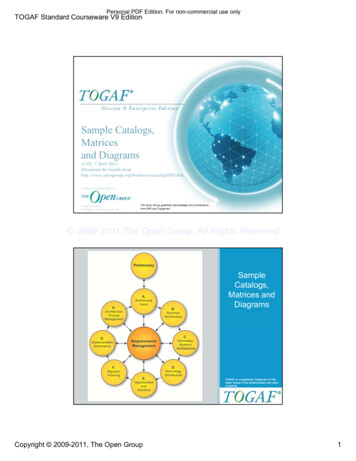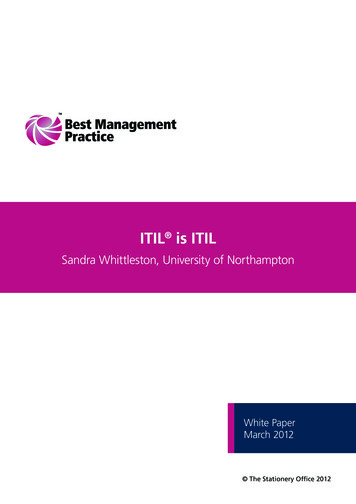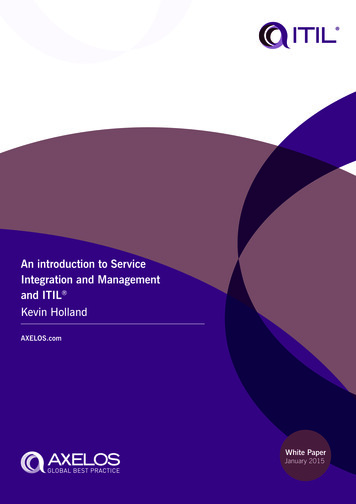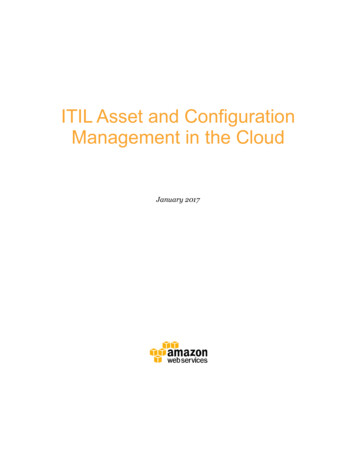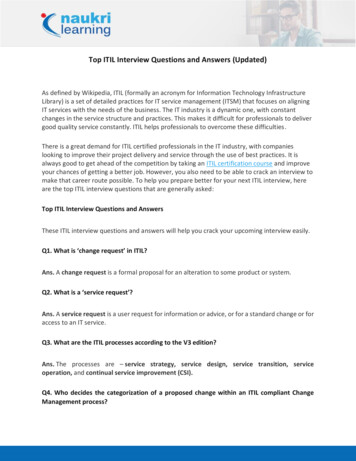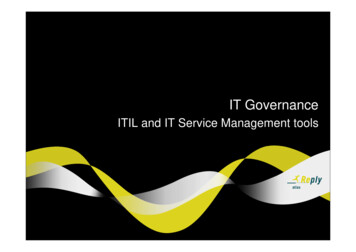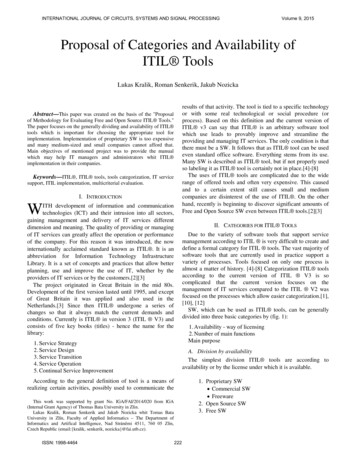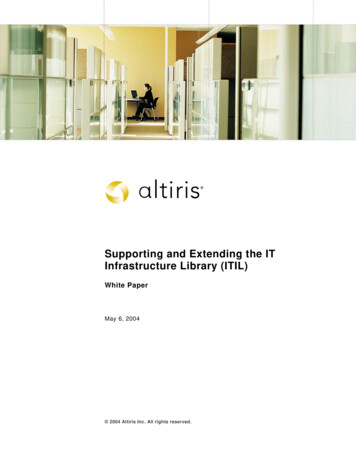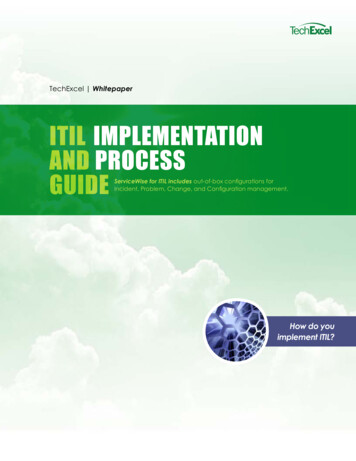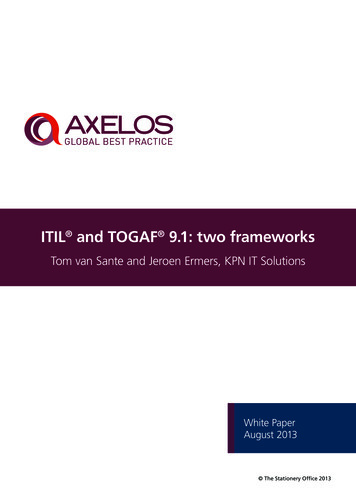
Transcription
ITIL and TOGAF 9.1: two frameworksTom van Sante and Jeroen Ermers, KPN IT SolutionsWhite PaperAugust 2013 The Stationery Office 2013
2ITIL and TOGAF 9.1: two frameworksContentsManagement summary31Introduction32Organizational development33History of ITIL44History of TOGAF55The framework dilemma66Where ITIL and TOGAF meet77Conclusions10Appendix10References and further reading11About the authors12Acknowledgements12Trade marks and statements12 The Stationery Office and TOGAF 2013
ITIL and TOGAF 9.1: two frameworksManagement summaryThis White Paper traces the development of The Open GroupArchitecture Framework (TOGAF ) and ITIL as a backgroundto discussions about the potential overlap in the processesthey both describe. It does not give an account of the modelsthemselves. Further details about these frameworks are given inthe References section at the end.The development of information systems in large organizations,and in multipart supply-and-demand chains, has becomecomplex and flexible. Increasingly, systems are being designedand managed using a structured approach. Best-practicemodels are based on the experience of day-to-day users andtherefore support users’ needs. The development of thesemodels follows the requirements of the organizations thatdeploy these models. In a way, they change from descriptionsof best practice to theoretical models of how processes shouldwork in practice.Both TOGAF and ITIL are frameworks that follow a processapproach. They are based upon best practice and are supportedby a large community of users. However, whereas TOGAFis focused on enterprise architecture, ITIL focuses on servicemanagement. During the years of development of theseframeworks, the domains they have described have changedfrom IT to business processes. In recent final versions, the twoframeworks appear to have entered into each other’s domains.In this White Paper we try to explain that although thesemodels describe similar processes, you do not have to choosebetween them. It is more important that the people whoare concerned with service management understand TOGAFand that enterprise architects understand ITIL – because inmost large companies both will be used in parallel. As most ITarchitects will probably have more knowledge of TOGAF thanITIL, and vice versa, this White Paper will help architects andservice managers to understand how these two frameworksare interrelated. Perhaps even more importantly they shouldunderstand how the ‘other’ framework can enhance the valueof their ‘own’ framework.3that their strength is in the common vocabulary they provide toprofessionals all over the world. However, do not assume that theyare meant to be followed blindly, as every organization will find itsown method of implementation in its day-to-day operations.Although ITIL and TOGAF describe areas of common interest, it isnot necessarily from the same perspective. ITIL was developed tosupport service management and TOGAF to support organizationsin the development of enterprise architecture. The focus of ITIL istherefore on services, whereas TOGAF is focused on architecture.However, since services have become an integral part of fastchanging organizations, predicting what will be needed tomorrowis of growing interest to the people who deliver these services.Conversely, architecture has changed from a rather static designdiscipline to one that encompasses the whole organization, andit is only useful if the whole organization is using it to enable alldevelopments to be aligned with each other.Service management has matured from a mere operational taskto one that can be practised at chief information officer level.Architecture has developed from a technical discipline to onefulfilling the role of trusted adviser to senior-level management.Therefore, the question of identifying where one ends and theother begins has changed over the years. A common way to lookat their domains of interest, and their role in the organization as awhole, is depicted in Figure 1.Figure 1 The domains and roles of ITIL and TOGAF withinan organizationSource: Radhakrishnan (2008).1IntroductionThe last major refreshes of ITIL and TOGAF were in 2007 (ITIL) and2009 (when TOGAF 9 succeeded TOGAF 8.1.1). Since then, bothframeworks have been updated; ITIL was updated in July 2011 andTOGAF 9.1 was released in December 2011. Both frameworks havelarge user groups and the continued progression of their contentshows that their development is ongoing.Because of these large user groups, the number of companiesthat work with both frameworks is growing. Questions ariseabout how to use these models side by side or choose betweenthem. In this White Paper these questions are answered byexplaining the background and history of the frameworks. Weneed to understand that they are both based on best practice and2Organizational developmentWe are living in a time when information is being spread withinand between organizations with hardly any restrictions. Newpossibilities will make this flow of information grow enormously.Information technology has become a complex matter in whichnot every individual will find their way. IT departments arebecoming increasingly complex and are having to control andmanage this complexity. Adjusting to rapid change has becomea dominant factor in controlling IT developments.This is especially true today, with organizations outsourcingmore and more functionality and bringing parts of their IT‘into the cloud’. Issues such as governance and security are The Stationery Office and TOGAF 2013
4ITIL and TOGAF 9.1: two frameworksbecoming more complex, and there is a growing interest amongorganizations in bringing processes to a higher maturity level inorder to control the risks involved.The early IT departments were typically extensions of theaccounting or, less commonly, the administrative departmentswithin organizations. They tended to operate in a stand-alonemode and were not connected with the primary businessprocesses. IT organizations were grouped in separate silos,and were described as the ‘network team’ or the ‘systemmanagement team’. It was in that era that standards for servicemanagement and architecture were first formulated. The speedof change in those times was a lot slower than it is today. Therewas enough time to plan and organize processes to last for along period.‘Quality’ was the magic word and this became the focusof many of the first improvements. A large number oforganizations concentrated on describing their activities inorder to make their outcomes predictable. However, that wasonly possible in times of relatively slow change, and theseactivities were geared more to the organizations themselvesthan to the customers involved. The improvements and actionswere activity-based. The next step in improving organizationstherefore focused on customer satisfaction, promoting thegeneral idea that services needed customers in order to have a‘raison d’être’.As business started to recognize the potential of IT forsupporting primary business functions, IT became increasinglyentangled in the business itself. Initially this occurred betweenthe financial and business functions; and then later between thebusiness functions, thereby increasing the added value of theproducts and services the business provided to its customers.Nowadays the information flow supported by IT has crossedboth geographical and organizational boundaries as bothsuppliers and customers have started to participate, thus furtherincreasing the added value. IT has also provided the means toenter markets that were hitherto inaccessible.A quick glance at the credit crisis of 2007 demonstrates howmuch organizations are affected by the problems of powerfuland dominant players in these information networks. Bothbetween and within organizations, departments have to rely oneach other. Organizations continuously make centralization anddecentralization efforts in order to maintain their competitiveadvantage. At the same time, outsourcing informationsystems that support core processes can cause difficulties foran organization in the development of its future informationsystems and service capability.The trend towards organizing work based on best-practicemodels is a result of this growing complexity. The possibilityof an international market supported by the internet has alsoforced organizations to improve their productivity. Althoughbest-practice models have been helpful, their use concealsa fundamental problem. The fragmented way in which ITservices are being built across different departments, or evenby external parties, makes the development and day-to-day The Stationery Office and TOGAF 2013management of these services even more complex. This explainsthe more holistic approach of existing models to keep a gripon all elements in the supply chain. All-encompassing modelstry to harness this development, but it will be impossible todirect all the players in the network. Therefore the ‘commonlanguage’ part of TOGAF and ITIL is more important than thecompleteness of the processes they describe.Today’s IT is often a combination of many components thatneed to be aligned seamlessly in order to be perceived as aservice to the end-user.3History of ITILITIL was first released to the public in the late 1980s by theCentral Computer and Telecommunications Agency (CCTA),an office of the British government, and as such was and stillis vendor-neutral. ITIL V1 consisted of 42 separate books. Therationale behind ITIL was, of course, to describe best practicesconcerning the management of IT. Those best practiceswere mainly based on experience in data centres running bigmainframes; at this time the PC was just being introduced andwas not yet a common sight in the office or in everyday life.This first set of ITIL books was, as can be expected from a firstversion, somewhat ambiguous in its conception: the distinctionbetween processes, work activities and organizational units wasnot very clear. Some of the books (such as those on changemanagement and problem management) concentrated onprocesses; some focused on both process and organization (forexample, the helpdesk); while a third group described a set ofactivities that were related without actually being a process(for example, network management). As a general rule, the42 books of ITIL V1 can be characterized using terms such as‘data centre’, ‘internal IT perspective’ and ‘the focus on sets ofrelated activities’. In the early 1990s this first set of ITIL bookswas extended, three of which were written from an altogetherdifferent perspective, oriented towards the business. Knownas the business perspective set, these books were: In Times ofRadical Change; Understanding and Improving; and Surviving ITInfrastructure Transitions.In 2000, ITIL V2 was launched. Authors were sought from therapidly growing worldwide IT service management community. InITIL V2, related processes were bundled together, thus reducingthe number of books from 42 to eight. ITIL V2 distinguishes itselffrom its predecessor mainly by emphasizing the need for closerelationships with both the customer and the supplier, therebyadopting a more service-oriented approach. The core focus ofITIL V2 can be defined as truly process-oriented, but still froma mainly internal IT perspective. ITIL V2 helped organizations toimprove the quality of their services and became an importantaid in implementing formal quality systems such as ISO/IEC 9000and EFQM.
ITIL and TOGAF 9.1: two frameworksITIL V2 also included best-practice guidance on how to use andapply ITIL. A separate volume, Planning to Implement ServiceManagement (Office of Government Commerce, 2002), provideddetailed guidance and introduced concepts with regard to themanagement of change. Instead of being solely a description ofan IT utopia, ITIL V2 showed you how to actually get there. Bythe time V2 was released, ITIL had become a worldwide de factostandard for IT service management – especially in the moreoperational processes where ITIL had a lot of followers. This wasreflected not only in the large number of people completingITIL training courses and the growth of itSMF, but also in theadaptation of ITIL by the British Standards Institute. This involvedthe incorporation of the ideas behind ITIL in the BSI standardBS 15000 (now ISO/IEC 20000).In 2007, ITIL V3 was launched. This version introduced thelifecycle principle, whereby the provision of services wasconsidered to be a continuous process in which new serviceswere brought into existence whilst others were phased out. InITIL V3 the focus was on this cycle of life, renewal and eventualdecommissioning of services rather than on the servicesthemselves. Once again the number of books was reduced; theITIL core guidance now consisted of five publications (Office ofGovernment Commerce, 2007). The ITIL V3 processes were,not surprisingly, brought together according to the place theyoccupied in the lifecycle. As it was recognized that the birth ofa new service (or, for that matter, the adaptation of an existingservice) was almost always triggered by business need, alignmentwith the primary business processes got to play a much biggerpart than it did in the previous versions of ITIL. Furthermore,IT was increasingly considered to be a strategic asset to thebusiness. Therefore, ITIL V3 placed much greater emphasis ondefining and implementing a service strategy. At the time, thiswas quite a new concept to IT service management. One of thebig differences between the two previous versions of ITIL and V3is that V3 adopted a more business-focused perspective, basedon the philosophy of ‘Don’t ask what the business can do foryou, ask what you can do for the business.’ITIL V1 and V2 contain hardly any references to architecture asa concept, method or framework. For example, in V2 of ICTInfrastructure Management (Office of Government Commerce,2002), the word ‘architecture’ is frequently used, but only in thesense of a design, and not in the sense that is used in subsequentversions of ITIL and TOGAF.It is clear that the development of ITIL has been stronglyinfluenced by the development of organizations in general.Furthermore, its scope has even grown to areas outside of ITto enable IT services to keep in line with constantly changingbusiness needs.ITIL was most recently updated in 2011 in response to issuesraised through the change control log, advice from the changeadvisory board and feedback from the training community. TheITIL 2011 editions share a similar standard structure to improveconsistency and aid navigation. The update project removederrors and inconsistencies, both in content and presentation,5and clarified the concepts relating to service strategy. The ITILcore (Cabinet Office, 2011) now consists of the following fivepublications, each of which is also a lifecycle stage: ITIL Service Strategy ITIL Service Design ITIL Service Transition ITIL Service Operation ITIL Continual Service Improvement.4History of TOGAFAs with ITIL, TOGAF has a long history. It was developed andis currently maintained as a standard by The Open Group,a vendor- and technology-neutral consortium focused on adiverse range of open standards and affiliated certificationprogrammes, and also for advancing the profession ofenterprise architecture.The first version of TOGAF, developed in 1995, was basedon the US Department of Defense’s Technical ArchitectureFramework for Information Management (TAFIM). Followingon from this, The Open Group Architecture Forum hasdeveloped successive versions of TOGAF at regular intervalsand published each one on The Open Group public website atwww.opengroup.orgEach version of the TOGAF standard is developed collaborativelyby the Architecture Forum, which currently has more than250 corporate members, including vendor and customerorganizations. The development is carried out by architecturepractitioners, the content being based on proven best practicesthat evolved within the participating member companies.The first seven versions of TOGAF addressed technologyarchitecture based on the way each was adopted by businessat the time of writing. In 2002, V8 (the ‘enterprise edition’)was published, and was followed by a series of improvementsin 2003 (V8.1) and 2006 (V8.1.1). By including business andinformation systems architecture, the new version expandedthe scope of TOGAF from a purely technology architecture toan enterprise one.In 2004, The Open Group launched a TOGAF certificationprogramme for individuals and organizations. Anybody whowanted to be certified as a practitioner of TOGAF could eitherattend an approved training course presented by a trainingprovider or complete an online examination. There has beena popular uptake of this programme by architects globally; inDecember 2012 there were more than 12,000 TOGAF 9certified professionals, emphasizing that TOGAF is one of theleading architecture frameworks worldwide.The role of architecture in organizations has changed froma focus on design to one that attempts to explain the detailsof the existing and future states of certain parts of the ITcapability in an organization. Increasingly it is about helping The Stationery Office and TOGAF 2013
6ITIL and TOGAF 9.1: two frameworksorganizations to make the right decisions about their futureand showing them how to get there. By combining inputfrom different stakeholders, architects can help organizationsto reduce the complexity of today’s IT and organizationallandscape. The growing success of a framework such asTOGAF underlines this development.TOGAF was one of the first models to have a strong emphasison this process approach to architecture in the organization.In fact, architecture must be seen as an organization-wideprocess that will be directed by management, with thesupport of the enterprise architect – who for this reason willhave changed from a technical individual to someone withorganizational sensitivity.As TOGAF evolved into V8.1.1, alongside a higher level ofdetail in the description of the architecture, there was alsoincreasing reflection on the use of the architecture and itsgovernance. This marked the point where TOGAF beganto deal with other fields of expertise. At this stage, whatcould be achieved by means of the architecture becameTOGAF’s biggest concern. This, in a way, was the same kindof development that occurred in ITIL, where support to thebusiness was (and still is) vital. In TOGAF the ultimate goalwas not the architecture itself (as described in differentartefacts) but the things an organization could achieve with it.Furthermore, it was the owners and executors who receivedthe benefits of the new version of TOGAF at the deploymentphase and not the architect. The architecture focused moreon the ‘soft’ side of the discipline and less on the technicalcontent side.Following the publication of TOGAF V8.1.1, the ArchitectureForum began its work on TOGAF V9, which was released inFebruary 2009. In order to meet the needs of TOGAF users, asurvey was conducted in the first quarter of 2007 to determinethe requirements for the next version. Three prominent viewswere expressed: The need for closer alignment with the business The desire for simple implementation and greater usability A preference for the next version of TOGAF to be anevolution rather than a revolution.These views provided the required direction for the developersof TOGAF V9 to get started on the next revision. Emergingarchitecture trends were also considered, such as serviceoriented architecture and the emphasis on security, as wellas alignment with The Open Group’s vision of BoundarylessInformation Flow .TOGAF V9.1 was published in 2011 (The Open Group, 2011). Itincludes a set of maintenance updates based on the feedbackreceived from the 2009 publication of TOGAF V9. Thechanges are mostly upwards-compatible, adding clarification,consistency and additional details where needed. The Stationery Offic
ITIL, and vice versa, this White Paper will help architects and service managers to understand how these two frameworks are interrelated. Perhaps even more importantly they should understand how the ‘other’

